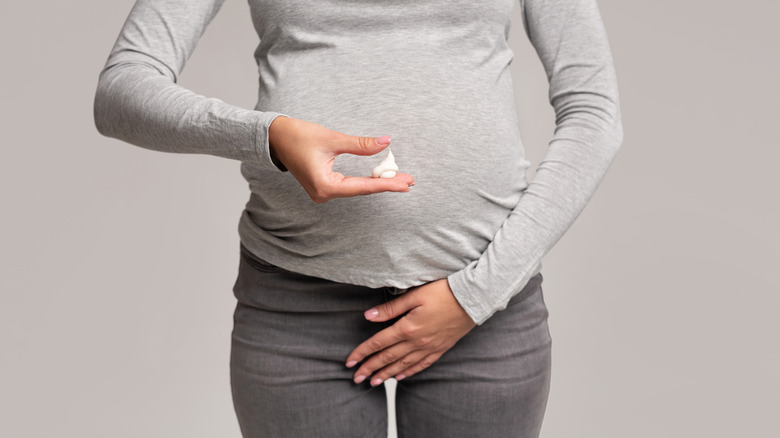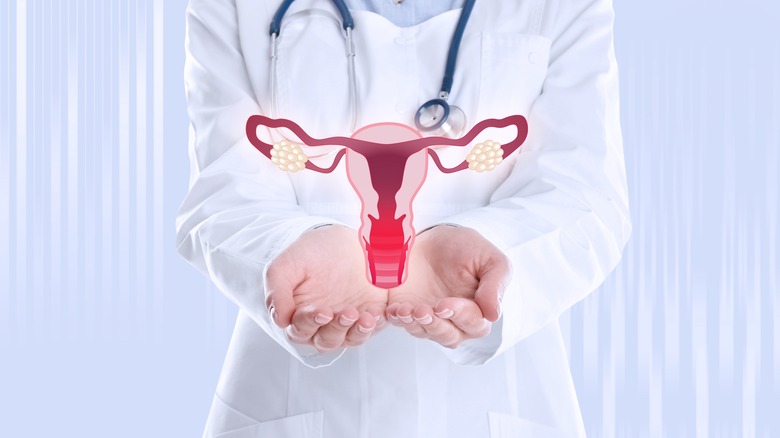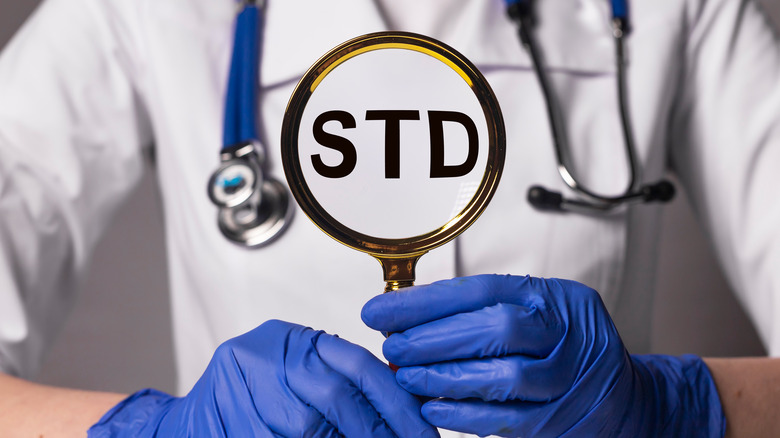How To Tell The Difference Between A Yeast Infection And An STD
The vagina is one of the various parts of the female reproductive system. Typical factors like unprotected sex, birth control, and feminine-hygiene products commonly affect vaginal health (via Mayo Clinic). Other factors include pregnancy, menopausal hormonal imbalances, and psychological issues, says the clinic.
Throughout a woman's cycle, different types of vaginal discharge might occur — identifying each one is a great way to understand your vagina's health. According to Medical News Today, vaginal discharge is normal and is caused by fluids excreting from tiny glands in the vagina and cervix. These fluids rid the body of old cells and debris, keeping the vagina and reproductive tract clean and healthy.
However, not all discharges are normal. For the most part, the color and consistency of the discharge can indicate if there's a health concern (via Healthline). In some cases, discharges are associated with sexually transmitted diseases (STDs) and yeast infections.
According to the Centers for Disease Control and Prevention (CDC), about half of STD cases in the United States occur in young people between the ages of 15 and 24. Each infection has unique causes, risk factors, and modes of transmission. However, telling the difference between a yeast infection and an STD can be tricky. Continue reading to delve into their characteristics.
What is a yeast infection?
According to Planned Parenthood, yeast infections are also known as vulvovaginal candidiasis. Although yeast can cause an infection, it exists in every healthy vagina. It only becomes problematic when it grows too much, leading to an infection, per the source.
When you have a yeast infection, it can cause changes in your vagina's environment, says Planned Parenthood. Despite the discomfort, yeast infections aren't transmitted through sex — only in rare cases can they be passed on, says Healthline. Pregnant or breastfeeding mothers might also pass it on to their babies if the infection occurs during delivery or is present around the breast area when breastfeeding, per Healthline.
Some people are more prone to yeast infections because of their sleep and diet habits, among other factors like medications (via Medical News Today). Antibiotics, corticosteroids, and hormonal contraceptives can increase a person's susceptibility to yeast infections. The same applies if you're pregnant, become immunocompromised, or suffer underlying conditions like diabetes, per the source.
Symptoms of a yeast infection
Yeast infections can affect different body parts. Quite often, the affected location determines the symptoms you may experience, according to Medline Plus. The most common symptom of a vaginal yeast infection is a whitish-yellow and clumpy discharge, which sometimes looks like cottage cheese but can also be watery, making you uncomfortable (via Healthline).
According to WebMD, most people who develop vaginal yeast infections experience itchiness and discomfort. The infection might also come with redness and swelling of the outer part of the genitals. You might also experience pain or a burning sensation when peeing or during sex, per WebMD. However, these symptoms do not manifest in every infected person similarly. Some may experience mild or fewer symptoms; in others, the condition might be severe, per the Office on Women's Health. Furthermore, yeast infections may mirror the symptoms of STDs, so it's crucial to seek an early diagnosis.
What is an STD?
STDs are sexually transmitted infections that can spread through vaginal, anal, or oral sex (via Planned Parenthood). According to the World Health Organization, more than a million infections are acquired daily throughout the world, and most are asymptomatic.
Furthermore, there are over 20 types of STDs, and some may be more common in specific regions (via Medline Plus). For instance, the human papillomavirus (HPV) is the most common in the U.S., affecting over 79 million Americans (via Healthline). Other common ones include chlamydia, gonorrhea, syphilis, and trichomoniasis.
HPV spreads through skin-to-skin contact during intercourse and oral or anal sex. There are some reported cases where the infection spread after hand-to-genital contact, like fingering or handjobs, making the condition highly contagious.
Chlamydia, on the other hand, is a bacterial infection caused by Chlamydia trachomatis. It also spreads via sexual activity, per Familydoctor.org. People with chlamydia may develop other STDs like gonorrhea, which is caused by Neisseria gonorrhoeae, per WebMD.
Syphilis, which is caused by Treponema pallidum, can also be transmitted sexually; however, the infection can spread through direct contact with an active lesion, especially through kissing (via Mayo Clinic).
Lastly, trichomoniasis is caused by a parasite called Trichomonas vaginalis that spreads through unprotected sex or by using infected sex toys, per the National Health Service (NHS). This condition affects both genders differently. In women, the parasite's main targets are the vagina and urethra. In men, it usually affects the urethra, head of the penis, or prostate gland.
Symptoms of STDs
According to Healthline, some early signs of an STD include pain during intercourse or urination. Swollen testicles are also common in men, while women may experience vaginal itching and unexpected periods or bleeding after sexual activity. Both genders may often develop sores or rashes around the genitals accompanied by unexplained discharges or bleeding.
According to Healthline, people with different types of STDs may experience different symptoms. Some STDs come with more severe symptoms than others. For example, WebMD says syphilis may start as a cut, ingrown hair, or a harmless bump. However, the infection can develop into a second stage associated with skin rashes, followed by sores in the mouth, vagina, or anus. According to the source, untreated syphilis may lead to certain critical complications like nerve damage and brain problems. Even though such cases are rare, it occurs in 15% of people with untreated syphilis.
According to the National Institute of Allergy and Infectious Diseases, STDs can lead to severe complications and can cause long-term health issues. Some common complications include infertility, pelvic inflammatory disease, cervical cancer, and ectopic pregnancy.
When to see a doctor
The lines between yeast infections and STDs are often blurred. The most important distinction is that yeast infections are mostly not transmitted through sex, unlike STDs. Also, most yeast infections are usually not serious (via WebMD). According to Medical News Today, a mild yeast infection usually improves without treatment, but such situations are rare. Therefore, it's crucial to see your doctor even if your case appears mild.
According to Johns Hopkins Medicine, your doctor might ask about your symptoms and assess your medical history. While antifungal treatments are often the go-to option for people with yeast infections, some doctors recommend treatment options based on your overall health, age, or how much the infection has spread.
If you think you have STD, getting tested is crucial due to the evasiveness of symptoms and the likelihood of short to long-term complications. Treatment might also help prevent the infection from passing on to your partner. Most STDs are treated with antibiotics or antiviral drugs, depending on the cause. According to the Mayo Clinic, antibiotics can cure many STD-related infections, including gonorrhea, trichomoniasis, chlamydia, and syphilis. Antiviral drugs, on the other hand, are usually used for treating HIV and herpes.






